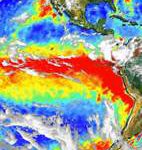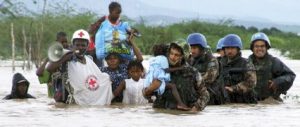In March 2007, the United Kingdom took the landmark step of putting the issue of climate change as a priority security risk to the United Nations Security Council. Four years on, Germany, which currently holds the presidency of the body, has reignited the debate, placing global warming and security back on the council’s agenda at a meeting yesterday. After a fierce discussion on the question of whether or not climate change poses a direct threat to international peace and security, the council issued a statement expressing concern over the “possible adverse effects”.
With the negative impacts of climate change already being felt around the world – most strongly in already poor and unstable states – why in four years has the debate stood still on this pressing security issue? What steps need to be taken to regain some of the political momentum behind the idea that climate change has an impact on security?
The nature of the relationship between climate change and conflict is interlinked and complex. Sectors such as water, agriculture, energy, health and trade will be highly affected by climate change and this could have a destabilising impact on a state’s ability to provide people with basic services. As climate change impacts interact with features of the social, economic and political landscape, countries with weak governance systems will become overwhelmed, and face a high risk of falling into political instability and violent conflict. The risk of instability both adds to the burdens faced by vulnerable communities, and makes it harder for them to adapt to climate change.
In southern Nepal, for example, when the Koshi River burst its banks in the summer of 2008, 240 people were killed, crops and infrastructure destroyed and 60,000 people displaced in the worst flooding in five decades.These people were resettled amongst communities who were themselves struggling to survive. Tensions between the host communities and flood victims quickly escalated and were further fuelled by political groups who used flood-victims’ unmet expectations for clean water and shelter to feed anti-government sentiments. The situation became violent and 200 policemen were called in to maintain order in the camps.
Clearly, climate change is not a climatic issue alone. Furthermore, it is evident that the security implications of climate change are first felt at the local level, and this is where they need to be understood.
In order to peacefully respond to climate change, we must not only consider the immediate natural impacts of climate change, but also the broader dimensions of resilience such as political power, livelihoods and access to justice. It is the interaction between the physical consequences of climate change and the social and political realities of people’s lives that will determine how effectively and peacefully they can adapt to climate change.
This is even more important in fragile contexts. Fragile states are characterised by very limited governance capacity where the government is barely capable of performing key functions, such as protecting citizens and property rights, enabling a functioning market, and providing social services, particularly education, health and sanitation. States which have recently emerged from conflict, as well as those facing economic instability or political unrest are also particularly vulnerable.
The uncertainties surrounding the impacts of climate change also hinder effective action; particularly in the third pole region, with the vagaries of Himalayan glacial melt flows and unpredictable feedback loops. Given the political contestation that accompanies uncertainty, and the complex social landscapes within which these impacts will play out, the most productive way of addressing the issue is to focus on “resilience”: that is, the capacity of a system to withstand shocks and respond to change – including unexpected change.
“Resilience” is a broader, more flexible, and therefore a more useful approach to climate change than “adaptation’. The latter tends to focus on specific anticipated climate effects, while resilience focuses on the capacity of people to act; for example their education, family networks, or access to markets.
Resilience, however, is most difficult to achieve where it is most needed –in places where states fail to meet people’s basic needs. States recovering from conflict such as Nepal, politically unstable countries like Pakistan, or environmentally vulnerable areas like Bangladesh may lack the capacity to adequately respond to environment shocks. Furthermore, where governance is already weak and the relations between citizens and the authorities are stretched, inappropriate responses to climate change may inadvertently cause further harm.
For example in Tajikistan, a multilateral donor-funded project aimed at providing local communities with a predictable water supply in the face of diminishing river flows, has caused conflict between two local ethnic groups. Tensions are grounded in the belief that the project is benefitting one community at the expense of the other; a situation which may or may not be true, but the perceptions of which are sufficient to fuel unrest.
Policy discussions about the consequences of climate change are beginning to acknowledge the conflict, security and governance implications. These concerns however focus on trans-boundary and international security implications, rather than local-level realities. They neglect the strong linkages between vulnerability to climate change, poverty and conflict. They pay scant attention to the complex vulnerabilities of households and communities. And they fail to acknowledge that the first trembles of climate-related insecurity will manifest at the local level before they threaten to escalate to the national or transnational level. It is at the local level that these vulnerabilities can most effectively be addressed.
In fragile contexts more than anywhere else, it is essential to realise how climate impacts – such as changing rainfall patterns, increased natural disasters and constraints to carbon-based economic growth – will have knock-on consequences on the national economy, trade, development, equity, governance andpolitical stability. For example, the rapid growth in use of crops for biofuels to ensure energy security in the face of soaring petrol prices, not only reduced food availability, but also drove millions of people off the land and contributed to food riots in 30 countries around the world. Such consequences affect the ability of people and governments to respond constructively to the challenges of climate change. The devastating floods that ravaged Pakistan last year fuelled widespread political unrest due to the perceived inability of the national government to adequately respond to people’s needs.
One characteristic of both understanding the problems and proposing solutions in this context is to focus on the linkages between development, peace, and climate resilience. For example, it would be impossible to address food insecurity without also thinking about land degradation and biodiversity, water management and biofuel production. It is not possible to address any one issue in isolation without understanding how they interact with each other, and how they interact will uniquely depend on the particular local dynamics at play.
Whilst there is increasing acknowledgement of the links between climate change, development and security within policy circles, beyond the rhetoric, practical measures to address these linked goals remain superficial, off-target and isolated. Most of the energy devoted to discussing climate-change adaptation focuses on responding to the direct environmental risks of climate change, for example by switching crops, building flood defences, moving homes and building dwellings differently. Important as it is to address the direct impacts, it is the knock-on social consequences – such as conflicts between displaced flood victims and host communities – that ultimately require more attention and resources. These knock-on consequences will be the most far reaching, yet remain the least understood.
So with Germany reigniting the debate on climate change and security on the UN stage this week, a window of opportunity opens to consider the complex and interlinked risks posed by climate change to local-level security. Policy responses to climate change and security must take account of the broad dimensions of resilience – not just drought-resistant crops and embankments to protect people from floods, but also: access to early warning information and the capacity to interpret and act on it; relationships of trust between citizens and authorities; viable livelihoods options, rule of law and efforts to combat corruption.
If these issues are taken on board, there is a good chance that adaptation efforts could yield a double dividend: increasing resilience to climate change and developing new approaches to poverty reduction. Failure to take account of the linkages however will result in widespread mal-adaptation and a monumental wasted opportunity.
Janani Vivekananda is senior climate change and security adviser in International Alert’s Security and Peacebuilding Programme and co-author of “A Climate of Conflict: The links between climate change, peace and war”, published by International Alert in 2007, and “Climate Change, Conflict and Fragility: Understanding the linkages, shaping effective responses”, published by International Alert in 2009.
Homepage image from Abdul Majeed Goraya / IRIN shows displaced people fleeing Sindh during the Pakistan floods.


